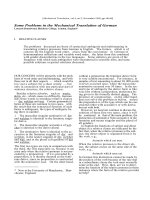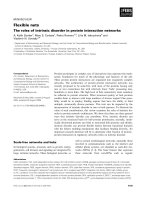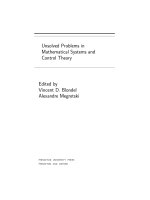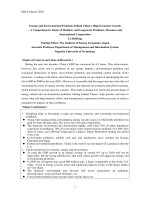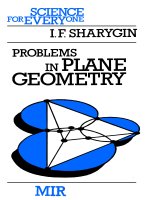Some problems in protein protein interaction network growth processes
Bạn đang xem bản rút gọn của tài liệu. Xem và tải ngay bản đầy đủ của tài liệu tại đây (1.51 MB, 124 trang )
SOME PROBLEMS IN PROTEIN-PROTEIN
INTERACTION NETWORK GROWTH
PROCESSES
LI SI
(B.Sc.(Hons.), SYSU)
A THESIS SUBMITTED
FOR THE DEGREE OF DOCTOR OF PHILOSOPHY
DEPARTMENT OF MATHEMATICS
NATIONAL UNIVERSITY OF SINGAPORE
2013
Declaration
I hereby declare that the thesis is my original work and it has been written by me
in its entirety. I have duly acknowledged all the sources of information which
have been used in the thesis.
This thesis has also not been submitted for any degree in any university
previously.
Li Si
12 July 2013
ii
Acknowledgements
I would like to express my gratitude to my parents and my family. They have
helped me throughout my education. Without them, this journey of pursuing my
Ph.D degree would be impossible.
I would also like to thank my supervisor Associate Professor Choi Kowk Pui
and my co-supervisor Associate Professor Zhang Louxin for their continuous en-
couragement, support and guidance during the past five years. Special thanks to
Dr. Wu Taoyang for helpful suggestions and cooperation.
I also thank all the members in our computational biology group for useful
presentations and idea sharing. Thanks to them, I have broadened my knowledge.
This list is by no means complete. I thank all the people who have help ed me
directly or indirectly.
iii
Contents
Declaration ii
Acknowledgements iii
Summary vii
List of Tables xi
1 Introduction 1
1.1 PPI Networks . . . . . . . . . . . . . . . . . . . . . . . . . . . . . . 2
1.1.1 Graph Representation and Properties . . . . . . . . . . . . . 4
1.2 Evolution of PPI Networks . . . . . . . . . . . . . . . . . . . . . . . 8
1.2.1 The Central Dogma . . . . . . . . . . . . . . . . . . . . . . . 9
1.2.2 Nodes Addition and Deletion . . . . . . . . . . . . . . . . . 9
1.2.3 Evolutionary Dynamics . . . . . . . . . . . . . . . . . . . . . 11
1.3 Modelling PPI Networks . . . . . . . . . . . . . . . . . . . . . . . . 13
1.3.1 Random Graph Models . . . . . . . . . . . . . . . . . . . . . 14
1.3.2 Growing Graph Models . . . . . . . . . . . . . . . . . . . . . 16
iv
Contents v
1.4 Objectives and Organization of Thesis . . . . . . . . . . . . . . . . 23
2 Reconstruction of Network Evolutionary History 25
2.1 Introduction . . . . . . . . . . . . . . . . . . . . . . . . . . . . . . . 25
2.2 Basic Definitions and Notations . . . . . . . . . . . . . . . . . . . . 27
2.2.1 Modeling Protein-protein Interaction Networks . . . . . . . . 28
2.2.2 Network History and its Reconstruction . . . . . . . . . . . 28
2.2.3 Duplication History . . . . . . . . . . . . . . . . . . . . . . . 30
2.2.4 Backward Operator . . . . . . . . . . . . . . . . . . . . . . . 31
2.3 Reconstruction with Known Duplication History . . . . . . . . . . . 32
2.4 Reconstruction Algorithms . . . . . . . . . . . . . . . . . . . . . . . 37
2.5 Experimental Results . . . . . . . . . . . . . . . . . . . . . . . . . . 42
2.5.1 Simulation Studies . . . . . . . . . . . . . . . . . . . . . . . 42
2.5.2 Parameters Estimation . . . . . . . . . . . . . . . . . . . . . 44
2.5.3 Application to Real PPI Networks . . . . . . . . . . . . . . . 47
2.6 Conclusion . . . . . . . . . . . . . . . . . . . . . . . . . . . . . . . . 50
3 Degree Distribution of Large Networks Generated by The Partial
Duplication Model 52
3.1 Introduction . . . . . . . . . . . . . . . . . . . . . . . . . . . . . . . 52
3.2 The Model . . . . . . . . . . . . . . . . . . . . . . . . . . . . . . . . 54
3.3 Preliminary Results and Notations . . . . . . . . . . . . . . . . . . 56
3.4 Rates of Convergence . . . . . . . . . . . . . . . . . . . . . . . . . . 61
3.5 The Non-isolated Subgraph . . . . . . . . . . . . . . . . . . . . . . 64
3.6 Limiting Behavior of Degree Distribution . . . . . . . . . . . . . . . 74
3.7 Discussion . . . . . . . . . . . . . . . . . . . . . . . . . . . . . . . . 78
4 Effect of Seed Graphs on The Evolution of Network Topology 82
4.1 Introduction . . . . . . . . . . . . . . . . . . . . . . . . . . . . . . . 82
Contents vi
4.2 Network Models and Parameters . . . . . . . . . . . . . . . . . . . . 84
4.3 Topological Statistics . . . . . . . . . . . . . . . . . . . . . . . . . . 86
4.4 Experiments and Results . . . . . . . . . . . . . . . . . . . . . . . . 87
4.5 Discussion . . . . . . . . . . . . . . . . . . . . . . . . . . . . . . . . 98
5 Conclusion and Future Work 99
Bibliography 101
Summary
The purpose of this thesis is to investigate the protein-protein interaction (PPI)
networks via network growth modeling: The duplication mo dels. The duplication
models are biologically reasonable and have been proved to give good fit for real
PPI networks. We have studied the evolutionary processes in two aspects: The
forward and the backward. Specifically, for the forward, time increases and a
network grows; for the backward, time decreases and a network is traced back.
We have studied one question in the backward aspect: What is the evolution-
ary history of an observed network? We answered this question by introducing a
novel framework which incorporates the duplication forest to reconstruct the net-
work evolutionary history. Under this framework, we reduced the searching space
for reconstruction by simplifying the likelihood ratio between two histories. We
proposed two algorithms: CherryGreedy (CG) and MinimumLossNumber (MLN)
for reconstructing network evolutionary history. MLN is based on a more intuitive
method and CG aims to provide more accurate results. Simulations show that
our algorithms outperform others. Our algorithms were used to investigate the
properties of real PPI networks from the view of evolution.
We have studied two questions in the forward aspect: (i) What is the degree
vii
Summary viii
distribution of a network when time is sufficiently large? and (ii) How does the seed
graph affect the evolutionary process of a network? For (i), we have done rigorous
mathematical analysis for the degree distribution of the partial duplication (PD)
model. First the existence of the limiting degree distribution was established. A
phase transition point for the PD model was showed. Moreover, the convergence
rates and the connected components have also been analyzed. For (ii), we have
run simulations to explore the topological statistics of four duplication models.
Several features have been presented. This part provides an open direction for
future work.
List of Figures
1.1 Examples of biological networks . . . . . . . . . . . . . . . . . . . . 2
1.2 Accumulation of network components . . . . . . . . . . . . . . . . . 3
1.3 Illustration of the central dogma . . . . . . . . . . . . . . . . . . . . 10
1.4 Illustration of gene duplication . . . . . . . . . . . . . . . . . . . . . 12
1.5 Evolutionary fate of duplicate genes . . . . . . . . . . . . . . . . . . 13
1.6 An ER model . . . . . . . . . . . . . . . . . . . . . . . . . . . . . . 15
1.7 Illustration of the Watts-Strogatz model . . . . . . . . . . . . . . . 16
1.8 An example for the PA model . . . . . . . . . . . . . . . . . . . . . 18
1.9 An example for the FD model . . . . . . . . . . . . . . . . . . . . . 19
1.10 Illustration of one step of the PD model . . . . . . . . . . . . . . . 21
1.11 Illustration of the DMC model . . . . . . . . . . . . . . . . . . . . . 22
1.12 Illustration of a time step in the DD model . . . . . . . . . . . . . . 23
2.1 An example of growth history and duplication history . . . . . . . . 29
2.2 A schematic representation of graph types used in the proof of
Proposition 2.4.2 . . . . . . . . . . . . . . . . . . . . . . . . . . . . 39
2.3 Average accuracy of three reconstruction methods . . . . . . . . . . 46
ix
List of Figures x
2.4 Box plot for errors of parameter estimation . . . . . . . . . . . . . . 47
2.5 Change in clustering coefficients over time in three PPI networks . . 49
2.6 Relationship between degree and number of duplications in three
PPI networks . . . . . . . . . . . . . . . . . . . . . . . . . . . . . . 50
3.1 Log-Log plot of degree distribution of the PDM model M(K
2
, p)
with p ∈ {0.1, 0.2, 0.3} . . . . . . . . . . . . . . . . . . . . . . . . . 71
3.2 Expected proportion of isolated nodes in the PDM model M(K
2
, p) 74
4.1 Plots for clustering coefficients of connected components in networks
generated by the DD model, the PA model, the PD model and the
DMC model . . . . . . . . . . . . . . . . . . . . . . . . . . . . . . . 90
4.2 Plots for average degrees of connected components in networks gen-
erated by the DD model, the PA model, the PD model and the DMC
model . . . . . . . . . . . . . . . . . . . . . . . . . . . . . . . . . . 91
4.3 Plots for average length of shortest paths in connected components
generated by the DD model, the PA model, the PD model and the
DMC model . . . . . . . . . . . . . . . . . . . . . . . . . . . . . . . 92
4.4 Plots for degree distribution of networks generated by the PD model 93
4.5 Plots for degree distribution of networks generated by the DD model 94
4.6 Plots for degree distribution of networks generated by the DMC model 95
4.7 Plots for degree distribution of networks generated by the PA mo del 96
List of Tables
2.1 Comparing the performance of MLN and CG . . . . . . . . . . . . . 43
2.2 Detailed comparison of NetArch and cherry greedy (CG) . . . . . . 45
2.3 Parameters and estimated parameters for three PPI networks . . . 49
3.1 Estimated power law exponent γ and selection probability p for three
PPI networks . . . . . . . . . . . . . . . . . . . . . . . . . . . . . . 73
4.1 Topological statics of seed graphs . . . . . . . . . . . . . . . . . . . 97
xi
Chapter 1
Introduction
Functioning of a living cell is attributed to the interplay between its numerous
components, such as DNA, RNA and proteins [9]. Despite their importance to
biological systems, none of these molecules can individually execute the complex
biological processes without collaboration with others. Therefore, understanding
the interaction and regulation of molecules is crucial in modern biology [110]. In
a conceptual and reductionism framework, there is a need to study the structure
and the dynamics of biological networks.
A network is a mathematical object which consists of a set of nodes and a set of
edges between them (see Subsection 1.1.1 for details). Depending on the molecules
represented by nodes and the interactions by edges, molecular networks can be
catalogued as metabolic networks, protein-protein interaction (PPI) networks and
gene regulatory networks etc. [25, 97] (Fig. 1.1). For example, in a metabolic
network, nodes correspond to biochemical metabolites and edges are chemical re-
actions that convert the reaction partners into substrates [25]. It should be kept in
mind that all these biological networks overlap with each other and none of them
stands alone in a living cell.
In the past decades, the advent of high-throughput experimental methods such
1
1.1 PPI Networks 2
(a) (b) (c)
Figure 1.1: Examples of biological networks. (a) A metabolic network of E. coli
with 574 interactions and 473 metabolites colored according to the KEGG pathway
classification [38]. (b) Yeast PPI network. Color of a node indicates its lethali-
ty [47]. (c) E. coli transcriptional regulatory network with transcription factors
colored with green and regulators colored with brown[39].
as yeast two-hybrid (Y2H) [30] and microarray [3] leads to the tremendous increase
of biological interaction data, allowing studies attempting to reveal the design
principles and evolutionary forces underlying biological networks [92]. Nonetheless,
in spite of some progresses (reviewed in [9]), the properties and mechanisms of these
biological networks are so far unknown.
1.1 PPI Networks
Among all the molecules in a living cell, proteins are essential parts of an organism
and perform the most vast array of functions [55]. In the past, proteins were
studied in isolation. Though remarkable knowledge on individual proteins has been
gained [83], the functioning machinery of an organism cannot be comprehensively
understood without investigation into the links between biological molecules, in
particular, protein-protein interactions (PPI).
Protein-protein interactions are physical contacts between two or more proteins
1.1 PPI Networks 3
in a living cell or organism, often to carry out important biological processes. For
example, G protein-coupled receptors interact with G proteins to transmit signals
from stimuli outside a cell [84]. There are two main experimental approaches in
wide use for detecting protein-protein interactions in large scale: Yeast two-hybrid
(Y2H) [30] and tandem affinity purification coupled to mass spectrometry (TAP-
MS) [81]. These high-throughput detection methods have led to the availability
of large quantity of interaction data (Fig.1.2), which enable analysis of evolution
and functionality of molecular and organisms. Large-scale experiments have been
embarked on model-organisms, such as S.cerevisiae [45, 94], C.elegans [58, 99],
Helicobacter pylori [78], D.melanogaster [36], and human [91]. These interaction
data are collected and organized in databases, such as DIP [105], IntAct [49] and
BioGRID [15], for easy reference.
Figure 1.2: Accumulation of network components during the 10 years from 1999
to 2009. Image from [106].
1.1 PPI Networks 4
1.1.1 Graph Representation and Properties
In mathematics, a network, which is also called a graph, consists of two compo-
nents: Nodes and edges, where edges are an indicator function on the set of nodes.
Specifically a set of nodes V and a set of indicator functions E = {e
i,j
}
i,j∈V
, define
a graph G(V, E), in which e
i,j
= 1 if there is an edge between node i and j and
e
i,j
= 0 otherwise. If the pair of nodes (i, j) in the subscript of the indicator func-
tion e
i,j
are ordered (unordered), the graph G are called directed graph (undirected
graph). Since we cannot say which protein binds with which one, protein-protein
interactions are considered to be undirected. Hence in this thesis we focus on undi-
rected networks, which means the order of the couple (i, j) does not matter and
e
i,j
= e
j,i
.
Over the past decade, networks have been used to elucidate many complex
systems in different disciplines, including computer science, biology, technology
and social science. In biology, network provides a useful tool to represent and
study interaction data of different types in cellular systems, such as protein-protein
interaction, metabolic and gene regulation [9]. By investigating the interactions at
a network level, new insights into the molecular mechanisms behind these systems
can b e discovered [97]. For example, a protein-protein interaction (PPI) network of
the plant Arabidopsis thaliana containing about 6200 physical interactions between
about 2700 proteins was constructed and reported in [4]. A study [65] based on it
indicated how pathogens may exploit protein interactions to manipulate a plant’s
cellular machinery.
In PPI networks, nodes are proteins and edges are protein-protein interactions.
Usually, a PPI network represents a collection of protein-protein interaction data in
an organism. For example, by incorporating all the PPIs of the yeast obtained from
a genome-scale study (such as [45]) we can generate a yeast PPI network. In order
to understand the functioning and formation of a network, the first step should be
1.1 PPI Networks 5
to investigate its properties, which can be explored through the quantifiable tools
of network theory. Network theory developed in other fields, such as Internet,
physics, and sociology [18], can provide great help for the study of PPI networks.
Several software tools have been introduced for network analysis. For example,
the most commonly used software Cytoscape enables visualization and analysis
of networks [87]. Even more powerful applications and extensions can be made
via user-defined plug-ins. Another popular software to ol GraphCrunch2 addresses
network modeling, alignment and clustering [54].
If there is a link b etween node i and node j, we say i is a neighbor of j and
vice versa. The number of neighbours of a node i is called its degree:
k
i
=
j∈V
e
i,j
.
It has b een found that the degree of a protein has significant biological implications.
The essential genes, whose malfunction would cause the death of an organism, are
found to positively correlate with their degrees [47].
Probably the most basic quantity to investigate a network is the degree distri-
bution P(k), which can be defined as the proportion of nodes with degree k or,
equivalently, the probability that a node, which is chosen uniformly at random,
has degree k. Some interesting patterns of degree distribution have been realized
in empirical networks. For example, scale-free is a widely observed characteris-
tic in real networks, which means networks with a power-law degree distribution:
P (k) ∼ k
−β
, where β is call the power-law exponent. In a scale-free network most
nodes have a small number of interactions and a few nodes, the so-called hubs,
interact with a large number of nodes. Owing to this property, scale-free networks
are surprisingly robust against random external attack. Disabling a few number
of nodes chosen at random would not cause fatal effect on a scale-free network. A
1.1 PPI Networks 6
scale-free network can tolerate up to 80% of its nodes to be disabled and still func-
tions properly [77]. It is believed that scale-free property is shared by a wide range
of real networks. Several non-biological networks, such as World Wide Web, social
networks and citation networks, are scale-free, with power-law exponents greater
than 2. The biological networks, such as yeast PPI network, E. coli metabolic net-
work, yeast gene expression network and gene functional interactions, also follow
a power-law, but with power-law exponents smaller than 2 (reviewed in [18]). A
quantity relative to the degree distribution regards the average degree, which is
defined to be the first moment of P (k):
D =
k
kP (k) = 2e/n,
where e =
i<j
e
i,j
is the number of edges and n = |V | is the number of nodes.
Other topological features commonly investigated include diameter, clustering
coefficient and betweenness etc. Here we give a brief review on these three quanti-
ties. We first define the concept of path. Given two nodes, i and j, a path between
i and j is a sequence of edges in which i and j as the two terminals and we can
traverse from i to j by visiting each edge in the path exactly once. If there is no
cycle in the path, we call it a simple path. The length of a path is the number
of edges that the path contains. The shortest path between two nodes i and j is
the path with the shortest length, which is called the distance between these two
nodes, denoted by l
i,j
. In a network, the maximum distances over all pairs of nodes
is called diameter:
Diameter = max
i,j∈V
l
i,j
.
A network with a small diameter is called a small-world network, in which a node
can reach any other node by traversing a few number of connected nodes. This
property allows efficient and prompt information transition in a network. Signal
1.1 PPI Networks 7
transduction and communication are tasks of many real networks. For instance,
in PPI networks, signaling molecules from the exterior of an organism bind the
receptor protein and signals are mediated through a sequence of protein-protein
interactions to eventually activate the organism’s reaction to the external signal-
s [59]. The small-world effect has been found in many real networks, such as
film actor corporation networks, power-grid networks and the yeast coexpression
network [69, 101]. The emergence of small-world effect suggests that these real
networks are likely to organize in such a way which facilitates signal and informa-
tion transmission. Finally we introduce another important topological quantity:
Clustering coefficient. Clustering coefficient, denoted by c(u), of a given node u
with degree k is defined as the proportion of pairs of this node’s neighbors which
are connected:
c(u) =
i,j∈N(u)
e
i,j
k
2
,
where N(u) is the set of neighbors of node u. Equivalently, clustering coefficient is
the probability that u and its two neighbors that are chosen uniformly at random
from the set of the neighbors of u form a triangle. The average clustering coefficient
is the mean of the clustering coefficient over all nodes: ¯c =
∑
u∈V
c(u)
|V |
. Clustering
coefficient measures to what degree nodes tend to form a dense subgraph and it
is often used an indicator for the modularity of a network [9]. High clustering
coefficient has been observed in PPI networks, hinting at a high modularity. Given
a node u, the betweenness of u, denoted by b(u), is defined as the number of
shortest paths from all vertices to all others that pass through u:
b(u) =
i,j
p
ij
(u)/p
ij
,
where p
ij
is the number of shortest paths between i and j, and p
ij
(u) is the number
of shortest paths between i and j passing through u. Betweenness approximates
1.2 Evolution of PPI Networks 8
the information flow that passes through a node and the essentiality of a node in
the ability of a network to communicate [33].
Apart from the above quantities that describe the topology of a network, net-
works are often studied in terms of subgraphs, such as motifs and modules. Small
subgraphs with statistical significance, which are termed motifs, have gained much
attention in recent years. By applying methodologies for motif discovery, motifs of
small sizes, such as triangles, are identified [48, 63, 104, 107]. Biomolecular network
motifs are usually found to be associated with biological functions and considered
to be basic building blocks for biological networks [63]. In [104], proteins in motifs
are found to be conserved evolutionarily to a higher degree than those that are
not members of motifs, indicating the biological importance of motifs in evolution.
A mo dule in a PPI network refers to a subgraph consisting a group of proteins
and a group of interactions among them usually carry out important functions
and may form a protein complex. Besides PPI networks, modules are also ob-
served in networks of other fields such as World Wide Web and social networks [9].
Several techniques have been proposed to detect modules in PPI networks. For
instance, Bader and Hogue [6] proposed the molecular complex detection algo-
rithm (MCODE) which makes use of the so-called core clustering coefficient to
predict molecular complexes. And Sharan et al. [88] developed a greedy likelihood
algorithm called NetworkBlast to detect modules in protein interaction networks.
Modules are evolutionary conserved parts in PPI networks.
1.2 Evolution of PPI Networks
Like other biological networks, PPI networks evolve with time. Only if we under-
stand the evolutionary processes can we understand the network we observe today.
However, due to the limited information and technology the evolutionary dynamics
1.2 Evolution of PPI Networks 9
of PPI networks are still not well studied and the evolutionary mechanisms shap-
ing the topology of PPI networks are not well understood. New techniques and
methodologies are urged to explore the history of these networks.
1.2.1 The Central Dogma
Proteins are the “workhorses” that build up our body, but what monitor proteins
are DNA, a polymer that contains genetic instruction. Francis Crick’s central dog-
ma of molecular biology describes how the genetic information transfers between
the three major information-carrying biopolymers: DNA, RNA and proteins[19].
The dogma emphasises the direction of the flow of information. In short, genetic
information flow is formed by the following transfers: DNA→DNA transfer (D-
NA replication), DNA→ RNA transfer (transcription) and RNA→proteins transfer
(translation), known as the three general transfers (Fig.1.3). Other transfers are
believed to be abnormal. In the process of transcription information contained
in DNA is copied to a piece of messenger RNA (mRNA). Eventually mRNA is
matched to transfer RNA (tRNA), thereby creating the corresponding amino acid-
s, which are linked and folded to form proteins.
1.2.2 Nodes Addition and Deletion
Every protein is encoded by a stretch of DNA, namely a gene. By the central
dogma, any mutation in the genome (the whole set of genes in an organism) may
cause a change in its proteome (the whole set of proteins in an organism). It is
observed that more than one third of genes in E. coli are orthologous to a human
gene but few are conserved in more than 90% of sequenced bacteria [46]. This
indicates that many genes are conserved across species and meanwhile the addition
and deletion of genes play a fundamental role in the variety of protein functions.
Gene loss, which is confirmed by the comparative analysis of sequences, is one of
1.2 Evolution of PPI Networks 10
Figure 1.3: Illustration of the central dogma. Genetic information is transmit-
ted from DNA to RNA and RNA makes the proteins via translation of the cod-
ed sequences. Image from " dogma of
molecular biology".
the major evolutionary force [5, 64]. However, from the point of view of modeling
a lost gene can be taken as a gene that never exists. Hence hereinafter we focus
on the addition of nodes. The introduction of a new no de into the genome can
be either through horizontal gene transfer or gene duplication, which is the most
frequent cases [106].
Gene duplication occurs in homologous recombination, which usually happens
as unequal crossover [37](Fig.1.4), a retrotransposition event or duplication of an
entire chromosome [109]. Gene duplication may happen in one single gene or a
large-scale region in the genome and even the whole genome, in which case we
call it the whole genome duplication (WGD). Gene duplication is widely observed
in the genomes of various species. For example, it is believed that the yeast S.
cerevisiae underwent a WGD about 150 million years ago [103]. The proportion
of duplicate genes, which are usually detected by sequence alignment methods, is
large and varies from more than 10% to over half [109]. Since the first reveal of
1.2 Evolution of PPI Networks 11
gene duplications in 1930s and prevalence of this notion by Ohno’s book in 1970,
Evolution by Gene Duplication [72], gene duplication has been viewed as the main
source of material for proteome evolution and play an an important role in devel-
oping novel functions. For instance, gene duplication is found to attribute to cold
adaptation in Antarctic notothenioids [14, 16]. Immediately after a gene duplica-
tion event we can find two identical genes in the genome, which carry out exactly
the same functions. The duplicate copy of a gene (or protein) is released from
the pressure of natural selection at the time point of duplication and is likely to
acquire a new, beneficial function that is preserved over time or lose the function
its origin has. Specifically, the duplicate genes would be preserved via comple-
mentary or degenerate mutations. The functions carried out by the two identical
duplicates would be partitioned by the pair, or one of them degenerates or acquires
new functions [31] (Fig. 1.5). Genes that degenerate and do not function any more
are called pseudogenes. Due to the functional redundancy, most duplicate genes
become pseudogenes or lost. It is reported that there are more than 60% pseu-
dogenes in human and 20% in mice [109]. However, the duplicate genes can be
conserved if they differ in different functions. For example zebrafish engrailed-1 and
engrailed-1b are conserved duplicate genes that are expressed in different tissues of
zebrafish [70].
1.2.3 Evolutionary Dynamics
Protein-protein interactions reflect the functions of proteins. The divergence of
protein functions may cause loss or gain of interactions. Some hypotheses have
been proposed for the evolution of PPI networks. For example, several authors
emphasize the effect of domain shuffling on shaping the top ology of PPI network-
s [13, 28, 34]. Among them, Evlampiev and Isambert proposed a model for PPI
network evolution based on a refined version of whole genome duplication, in which
1.2 Evolution of PPI Networks 12
Figure 1.4: Illustration of gene duplication. Image from "ipedia.
org/wiki/Gene duplication".
protein domains are introduced through different types of edges [28]. Preferential
attachment of newcomers is also considered as a factor affecting the evolution of P-
PI networks [20, 24]. For instance, based on the evolutionary conservation, Davids
and Zhang [20] classified the E. coli genes into three categories: Core genes, Non-
core genes and genes resulting from horizontal gene transfer (HGT). They claimed
that the HGT genes link with Core genes in a preferential attachment manner.
Some other authors focus on gene duplications (see [96, 98] for examples). By
studying the relation between the fraction of duplicates with at least one common
interacting neighbor and the fraction of synonymous substitutions per synony-
mous site [37], Wagner found that the higher the similarity between duplicates is
the more interactions the duplicates share [98]. Based on this observations, the
author proposed a model for the effect of gene duplications on the protein-protein
interactions. In this model, the process of evolution by gene duplication and diver-
gence is depicted as the rewiring of their adjacent links, including loss of adjacent
edges and gain of new adjacent neighb ors. This mechanism links the molecular
evolution with the network evolution especially in the aspect of gene duplication.
1.3 Modelling PPI Networks 13
Figure 1.5: Evolutionary fate of duplicate genes. A gene with four functions is
duplicated. In the divergence of the duplicate genes, four cases may happen: Sub-
functionalization, neofunctionalization and degeneration. In subfunctionalization,
functions are partitioned by the two duplicate genes. In this case, each carries out
two of the four original functions. In neofunctionalization, a duplicate gene obtains
new functions. Here one gene acquires two new functions. In degeneration, one of
the duplicate genes loses its functions and become pseudogenes or unidentifiable.
Image from " duplication".
1.3 Modelling PPI Networks
PPI networks that we observe today are results of millions of years of evolution.
Not only the proteins themselves undergo mutations and natural selection, but
also the interactions between them change with time. Even if the proteins remain
unchanged, the interactions may still vary (examples can be found in the conserved
modules in different sp ecies). Understanding how PPI networks evolve and how the
properties of PPI networks emerge would shed light on the functioning machinery
of a cell or organism and provide insight into human diseases at the molecular
level [97]. Like in other disciplines, such as physics, a proper model in biology can
provide a theoretical framework in the analysis of the dauntingly huge real data.
With the help of computers, processes that cannot be realized in reality (such as the
1.3 Modelling PPI Networks 14
reconstruction of PPI network evolutionary history, see Chapter 2 for details) can
be completed by embedding the models. A question should be asked beforehand:
What is a “proper” model? To the best of our knowledge, there is no definite
answer to it. However, the model should be simple enough to be mathematically
tractable, and consistent with biological facts and fits the real data to some extent.
Even if a model is not mathematically tractable and analytical results are difficult
to be obtained, simulation studies can also provide valuable insights into the real
networks of interest. Here we give a brief review on some interesting graph models
which may be useful in our research.
1.3.1 Random Graph Models
Probably the best known random graph is the Erd˝os-R´enyi (ER) model [26],
which is named after Paul Erd˝os and Alfr´ed R´enyi, who proposed the model in
1959. An ER model with n nodes and parameter p, denoted by M(n, p), generates
networks by independently connecting each pair in the n nodes with probability p
(Fig. 1.6). Note that there are
n
2
edges in a complete graph with n nodes and
under the ER model a network with n nodes and m edges, denoted by G(n, m), is
generated with probability p
m
(1 − p)
(
n
2
)
−m
. The degree distribution of ER model
is binomial [67]:
P (deg(v) = k) =
n − 1
k
p
k
(1 − p)
n−1−k
,
which converges to a Poisson distribution when n is large and np is fixed. Further
mathematical properties of ER model is described in [27]. There is another variant
of the ER model M(n, m), where n is the number of nodes and m is the number of
edges. In M(n, m), m edges are chosen uniformly at random from the
n
2
potential
edges. When pn
2
→ ∞, many graph properties in M(n, p) and M(n, m), with

